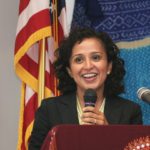What can philanthropic organizations do to reduce poverty in Southern California? What should they not do?
Swaim Poverty Q6

Don’t give up on California. We’ve seen too many organizations raise the white flag and either support disastrous government schemes or simply declare California hopeless.
Painter Poverty Q6

Philanthropic organizations can provide funding to test innovative strategies to reduce barriers to employment for households in poverty. They can also provide support for advocacy to support systems change.
Philanthropy should not be satisfied at only providing stabilizing supports.
Bornstein Poverty Q6

Foo Poverty Q6

Philanthropic organizations can invest in community leadership and neighborhood development to address policy and systems change. Funding services but also long term integrated voter engagement for all communities, regardless of their socioeconomic levels are engaged and have access to making local systems and policy change. Philanthropic organizations can also bring together diverse sectors to have the time to think and strategize how to partner to make change and reduce poverty – transportation, corporations, civic leaders, community based nonprofits, community leaders, spiritual centers, health care institutions, schools and educational institutions, etc. It can start small and at first and meet immediate needs – for example, providing funds for schools to have free washer and dryers available so students who are homeless can wash their clothes and not miss school, having funds for summer meals at school sites, wellness sites, etc. Anaheim Union High School District started CA Democracy Schools and their students have increased civic engagement and working on policy change. The school district has also supported and trained Parent Liaisons who have supported and encouraged hundreds of parents to be involved in the Local Control Accountability Plans and have a stronger voice in their district. AUHSD has also partnered with the Tesla Foundation, IBM, and Kaiser Permanente to create career development pipelines including cyber security, allied health, technology careers, and a number of other career pipelines. Santa Ana Unified started Wellness Centers at their school sites integrating wellness, health and mental health care as well as restorative practices. Lots of great partnerships and ideas already occurring that local and state government may not be aware of and philanthropy can support gatherings and strategy sessions to bring diverse sectors together to understand some of these models and how to integrate these ideas more widespread.
Kulkarni Poverty Q6

The single biggest way philanthropic organizations can reduce poverty is to fund advocacy and education work for state and local anti-poverty policy measures, which include not only higher wages, improved public education (pre-K through college) but also housing assistance and student debt relief. Additionally, they can fund research and development of studies that examine the impact of root causes such as racial discrimination, climate change, mass incarceration and unjust policing and immigration enforcement.
Hernandez Poverty Q6

Philanthropic organizations should continue the great work that they already do and partner with other nonprofits organizations, such as BizFed to multiply their voice with local, state, and federal elected officials, and connect with other philanthropic organization to increase awareness. We also hope the philanthropic community seeks out the business perspective and invites us to the table as they seek solutions.
A large part of our public commitment to reducing poverty in Los Angeles was to remind folks working on poverty that we’re here and can help. Business leaders are often solicited for donations but rarely approached as a thought partner. Of course, businesspeople are mostly focused on keeping their enterprises growing, so poverty alleviation is not usually a focus day today. But poverty is bad for business. Growing businesses are necessary for a functioning economy. A functioning economy solves most of its own problems. Strong businesses with good-paying jobs support philanthropic and government systems to take care of our neighbors who need extra help.
Philanthropic grantors should increase diligence in requiring measurable outcomes for gifts given. We find you get what you inspect not necessarily what you expect.
Buiza Poverty Q6

1) Some of the answers for what nonprofits should do also apply here
2) Five to ten multi-year funding for non-profits with a proven track record of impact.
3) Fund collaborative evaluation initiatives between non-profits and academia to measure impact and reduce overlap and repetition.
Rutherford Poverty Q6

Philanthropic organizations can help by sponsoring vocational and college scholarships for low-income students and supporting organizations that provide affordable child-care, mentoring, and other programs that give those living in poverty a hand up.
Hoss Poverty Q6

Philanthropic organizations are uniquely positioned to connect and convene individuals, nonprofits, businesses, and other community leaders to collaboratively tackle our community’s greatest needs.
For example, the Orange County Community Foundation is piloting a new initiative to address poverty by building pathways to living wage employment for unemployed and underemployed OC residents, with special emphasis on young adults aged 18 – 26 who are disconnected from both school and the workforce. We recently launched the pilot phase of a new Workforce Development Initiative in partnership with community colleges, nonprofits, and businesses designed to build strategic pipelines to employment in middle-skills jobs for graduating high school seniors enrolling in community college, disconnected older youth, and underemployed adults who may not have the means to advance their employment opportunities due to barriers such as lack of access to education and job training.
This initiative will help these individuals acquire in-demand technical acumen in continually evolving industries, primarily concentrated in the health care, advanced manufacturing, and information technology sectors, and prepare them for a strong and successful future. It will drive our community’s economic growth and fuel successful outcomes for next generations.
Philanthropic organizations must continue to seek opportunities for game-changing impact through innovative partnerships across sectors.
Campbell Poverty Q6

The philanthropic organizations can take a more general view; they tend to be a bit more removed from the pressures of delivering on daily needs for housing, medical care, training, or food. They are positioned to study best practices from other states and countries, to survey the academic literature, and to propose concepts for improving the delivery of basic needs. A non-partisan approach to improving government could also come out of the state’s major philanthropic organizations, like the Hewlett Foundation. Such concepts as the little Hoover Commission, and reforms in redevelopment agencies, were conceptualized from philanthropies in the past; the need is even greater now.
Bradbard Poverty Q6

Philanthropy can help to fill funding gaps often left between various government funding sources. Gaps exist in social services, basic needs provision, health care, and the development of affordable housing, just to name a few. By listening to and partnering with on-the-ground nonprofits, philanthropic organizations can identify these gaps and determine where their dollars can be leveraged for much greater impact. Through a regional lens, philanthropy can help reduce poverty by shifting dollars to areas where the needs are greatest and funding is most limited. Philanthropy can also leverage their resources and influence to impact needed policy changes that help address the challenges faced by those in poverty.
McKellogg Poverty Q6

Philanthropic organizations should support evidence-based, replicable program models, like employment social enterprise, that provide jobs, income, training and a path to economic mobility for individuals with extremely low incomes. Philanthropic organizations should consider using a portion of their endowments for social impact investing to provide growth capital to social entrepreneurs that are testing innovative approaches to poverty reduction. And philanthropic organizations should assess their own labor and procurement practices to ensure that they meet the highest standards for providing ‘good jobs’ to all who work for their organizations, and the companies in their supply chain.
Philanthropy, like government, should acknowledge the full cost of non-profit service providers and consider expanding general operating support and reducing more restrictive forms of funding in exchange for greater impact. Finally, one of the most pressing challenges right now in philanthropy is diversifying leadership and board representation. The inaugural Diversity Among Philanthropic Professionals Survey by the Funders for LGBTQ Issues is groundbreaking and shines a light on the demographics of the philanthropic workforce and how greater diversity, equity, and inclusion in the philanthropic community is tied to greater impact.
Pastor Poverty Q6

Philanthropy has actually been playing a positive role in this arena. For example, the Weingart Foundation commissioned an equity analysis of Los Angeles County and Orange County Grantmakers supported an equity analysis in the O.C. as well. The James Irvine Foundation has focused a large share of its recent philanthropic support on addressing the challenges facing the state’s low-wage workers. The California Endowment has invested in a range of low-income communities of color in Southern California, often funding the sort of grassroots organizing that can insure that community voices get heard in the policy-making process. The California Community Foundation – which is really L.A.’s community foundation – has supported a wide range of efforts, including critical support for immigrant integration. Both the United Way and the Conrad Hilton Foundation have led on making sure that homelessness is everyone’s issue. And there are many, many other foundations seeking to partner with the service providers and social justice organizers that can effectively move the needle on poverty.
But the problem is too big for just philanthropic dollars – and going forward, the role of the state, local government, and business will be critical. Another key issue for all those actors will be recognizing and addressing the racial dimensions of poverty. It may be uncomfortable for some to recognize how racial advantage and disadvantage have structured the unequal outcomes we see today. But the fact that median income for households with children under the age of five is about $111,000 for white families in Los Angeles County and about $43,000-45,000 for Black and Latino families is a recipe for reproducing generational disadvantage. Addressing race and racism will require challenging conversations as well as a clear-eyed analysis of how implicit bias still affects hiring and how the combination of neighborhood distress, over-policing, and inadequate workforce systems can limit horizons.
The good news is that we are Californians – and, indeed, we are Southern Californians. We have a long history of challenging inequity, expanding opportunity, and securing hope in the future. As we head to the Olympics in 2028, let’s make sure that the region that greets the world will be able to boast about not just its first-class venues, hotels, and transit but also about the historic progress it will have made on eradicating poverty, homelessness, and discrimination.
Belk Poverty Q6

Decades of public health research has shown that wealth is the strongest factor that influences health, but many Southern Californians face barriers to achieving financial security. For health funders like The California Wellness Foundation, investing our resources in efforts to reduce income inequality is one strategy to improve the health of low-income communities.
Foundations can make grants to organizations that integrate asset building strategies into health and human service programs. Financial coaching, credit repair and guidance in building savings can help families regain a stable economic footing. In Oakland, the Brilliant Baby program uses a two-generation approach to fighting poverty by offering financial coaching to low-income women through home visiting programs.
Foundations can also fund organizations that advocate for improved wages and benefits, including living wage campaigns. We’ve funded organizations like California Food Policy Advocates in Los Angeles to advocate for improved access to CalFresh and other public benefit programs.
And we can use our own voice to speak out when government loses sight of how policies impact families. For Cal Wellness, this recently meant providing public comment on the proposed changes to “public charge” rules that would have forced immigrant families to make difficult choices between meeting basic needs and keeping their families together in the United States.
While these strategies are important and can make real differences in the lives of those living in poverty in Southern California, we won’t be able to make long-lasting change without tackling structural inequalities tied to factors like race. Philanthropy can also play an important role here, if our boards of directors and my fellow CEOs are willing to engage in challenging conversations.
Salas Poverty Q6

Philanthropic organizations need to invest in civil society organizations that are helping reduce poverty and advocating for the policies that will promote prosperity for all. Philanthropic organizations can use their platform and influence to engage with local, regional and state government towards joint investment. Philanthropic organizations need to provide resources to strengthen civil society and not become the so prescriptive in solutions that creativity and ingenuity is limited in their grantees.